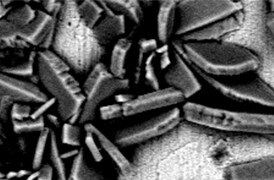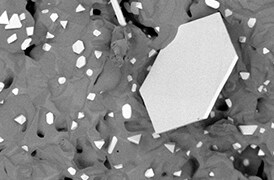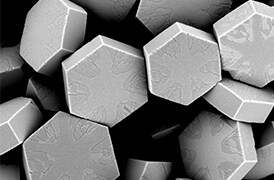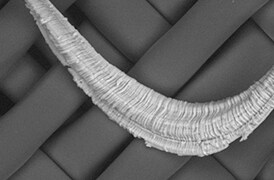Search Thermo Fisher Scientific
- Contact Us
- Quick Order
-
Don't have an account ? Create Account
Search Thermo Fisher Scientific

As the demand for high-performance materials increases, so does the importance of surface engineering. The material’s surface is its point of interaction with the external environment and other materials, and will influence factors such as corrosion rates, catalytic activity, adhesive properties, wettability, contact potential, and failure mechanisms.
Surface modification can be used to alter or improve these characteristics; surface analysis is used to understand surface chemistry and investigate the efficacy of surface engineering. From non-stick cookware coatings to thin-film electronics and bio-active surfaces, X-ray photoelectron spectroscopy is one of the standard tools for surface characterization.
X-ray photoelectron spectroscopy (XPS), also known as electron spectroscopy for chemical analysis (ESCA), is a technique for analyzing a material’s surface chemistry. XPS can measure elemental composition as well as the chemical and electronic state of the atoms within a material.
XPS spectra are obtained by irradiating a solid surface with a beam of X-rays and measuring the kinetic energy of electrons that are emitted from the top 1-10 nm of the material. A photoelectron spectrum is recorded by counting ejected electrons over a range of kinetic energies. The energies and intensities of the photoelectron peaks enable identification and quantification of all surface elements (except hydrogen).
The surface represents a discontinuity between one phase and another; the physical and chemical properties of the surface are, therefore, different from those of the bulk material. These differences affect the topmost atomic layer of the material to a large extent because a surface atom is not surrounded by atoms on all sides. This results in the surface atom having a bonding potential, which makes it more reactive than atoms in the bulk.
When you look at your sample, do you wonder which analysis technique will get you all the pertinent information you need? Is the answer usually that no one single technique will give you everything you need? To fully understand materials, you need to be able to analyze them using multiple techniques. When you use a single-instrument, multi-technique workflow, you can better expose your sample’s properties by exploring it with a combination of many techniques, including XPS, ISS, REELS, UPS, and Raman. Learn how you can get on the fast track to comprehensive surface analysis.
The chemistry of the surface of a material, or at the interfaces of layers, determines how a material behaves. Our surface analysis references and resources can help you engineer desired properties or better understand materials when they do not perform as expected.
Surface analysis contributes to the understanding of each of these areas:
|
|
Explore our information-packed knowledge base of elemental properties and XPS analysis.
Explore the many applications of XPS analysis.
Understanding XPS images and depth profiles with Avantage Software - Part 2
By watching the webinar, you will learn how to use the right tools to understand multi-level data sets, such as depth profiles and images.
Understanding Surface Chemistry with Avantage Software
This webinar is designed to offer training to current users of Avantage software and act as an introduction to those unfamiliar with it.
Surface Analysis of Thin Films
Explore a number of applications for thin film coating analysis including forensic studies, graphene, multi-layered glass, coated fabrics and photovoltaics.
Understanding Metal Surfaces and Oxides
XPS delivers chemical state information from the topmost nanometers of a sample surface, enabling you to measure passivation coatings, understand catalyst chemistries, and develop bio-compatibility coatings.
Multi-technique Surface Analysis and Cluster Ion Sample Cleaning
We present how a dual mode ion source can be used for multi-technique sample analysis, showing the importance of sample cleaning and how depth profiles can be performed.
Characterizing Polymers with XPS
This webinar covers the basics of X-ray photoelectron spectroscopy, with a special emphasis on how it can be used in the field of polymer surface analysis. X-ray photoelectron spectroscopy is a powerful technique for the chemical analysis of the surface of materials.
Understanding XPS images and depth profiles with Avantage Software - Part 2
By watching the webinar, you will learn how to use the right tools to understand multi-level data sets, such as depth profiles and images.
Understanding Surface Chemistry with Avantage Software
This webinar is designed to offer training to current users of Avantage software and act as an introduction to those unfamiliar with it.
Surface Analysis of Thin Films
Explore a number of applications for thin film coating analysis including forensic studies, graphene, multi-layered glass, coated fabrics and photovoltaics.
Understanding Metal Surfaces and Oxides
XPS delivers chemical state information from the topmost nanometers of a sample surface, enabling you to measure passivation coatings, understand catalyst chemistries, and develop bio-compatibility coatings.
Multi-technique Surface Analysis and Cluster Ion Sample Cleaning
We present how a dual mode ion source can be used for multi-technique sample analysis, showing the importance of sample cleaning and how depth profiles can be performed.
Characterizing Polymers with XPS
This webinar covers the basics of X-ray photoelectron spectroscopy, with a special emphasis on how it can be used in the field of polymer surface analysis. X-ray photoelectron spectroscopy is a powerful technique for the chemical analysis of the surface of materials.
Modern industry demands high throughput with superior quality, a balance that is maintained through robust process control. SEM and TEM tools with dedicated automation software provide rapid, multi-scale information for process monitoring and improvement.
Quality control and assurance are essential in modern industry. We offer a range of EM and spectroscopy tools for multi-scale and multi-modal analysis of defects, allowing you to make reliable and informed decisions for process control and improvement.
Novel materials are investigated at increasingly smaller scales for maximum control of their physical and chemical properties. Electron microscopy provides researchers with key insight into a wide variety of material characteristics at the micro- to nano-scale.
More than ever, modern manufacturing necessitates reliable, quality components. With scanning electron microscopy, parts cleanliness analysis can be brought inhouse, providing you with a broad range of analytical data and shortening your production cycle.

Battery development is enabled by multi-scale analysis with microCT, SEM and TEM, Raman spectroscopy, XPS, and digital 3D visualization and analysis. Learn how this approach provides the structural and chemical information needed to build better batteries.

Effective production of metals requires precise control of inclusions and precipitates. Our automated tools can perform a variety of tasks critical for metal analysis including; nanoparticle counting, EDS chemical analysis and TEM sample preparation.

Geoscience relies on consistent and accurate multi-scale observation of features within rock samples. SEM-EDS, combined with automation software, enables direct, large-scale analysis of texture and mineral composition for petrology and mineralogy research.

As the demand for oil and gas continues, there is an ongoing need for efficient and effective extraction of hydrocarbons. Thermo Fisher Scientific offers a range of microscopy and spectroscopy solutions for a variety of petroleum science applications.

Materials have fundamentally different properties at the nanoscale than at the macroscale. To study them, S/TEM instrumentation can be combined with energy dispersive X-ray spectroscopy to obtain nanometer, or even sub-nanometer, resolution data.

Micro-traces of crime scene evidence can be analyzed and compared using electron microscopy as part of a forensic investigation. Compatible samples include glass and paint fragments, tool marks, drugs, explosives, and GSR (gunshot residue).

Catalysts are critical for a majority of modern industrial processes. Their efficiency depends on the microscopic composition and morphology of the catalytic particles; EM with EDS is ideally suited for studying these properties.

The diameter, morphology and density of synthetic fibers are key parameters that determine the lifetime and functionality of a filter. Scanning electron microscopy (SEM) is the ideal technique for quickly and easily investigating these features.

Novel materials research is increasingly interested in the structure of low-dimensional materials. Scanning transmission electron microscopy with probe correction and monochromation allows for high-resolution two-dimensional materials imaging.

Every component in a modern vehicle is designed for safety, efficiency, and performance. Detailed characterization of automotive materials with electron microscopy and spectroscopy informs critical process decisions, product improvements, and new materials.
Microelectronics
Oxides & Metals
Polymers
Routine Analysis
SnapMap
Tribology
To ensure optimal system performance, we provide you access to a world-class network of field service experts, technical support, and certified spare parts.






